
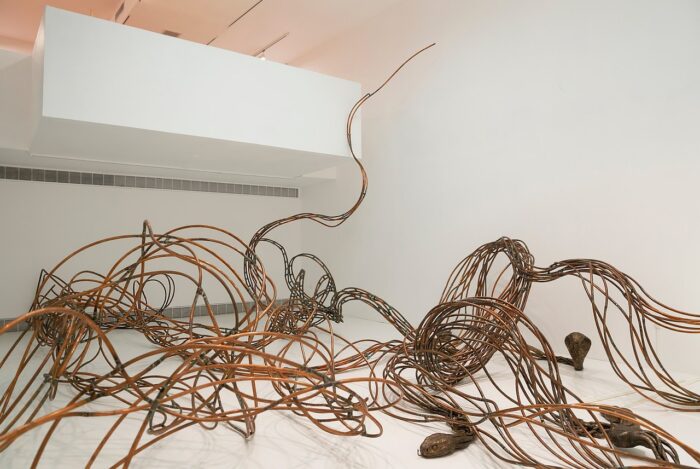

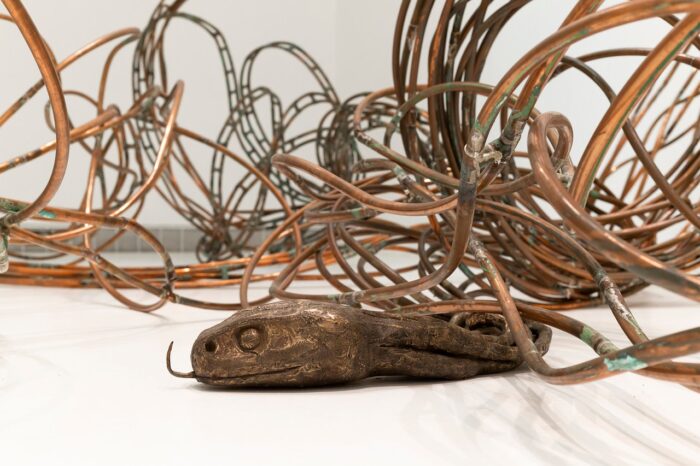
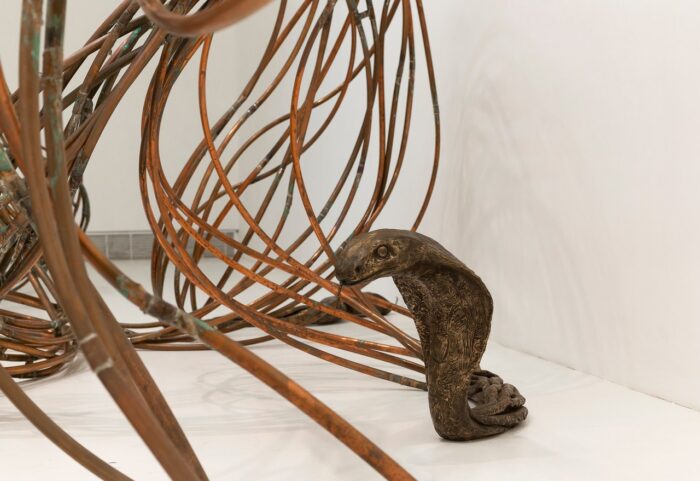
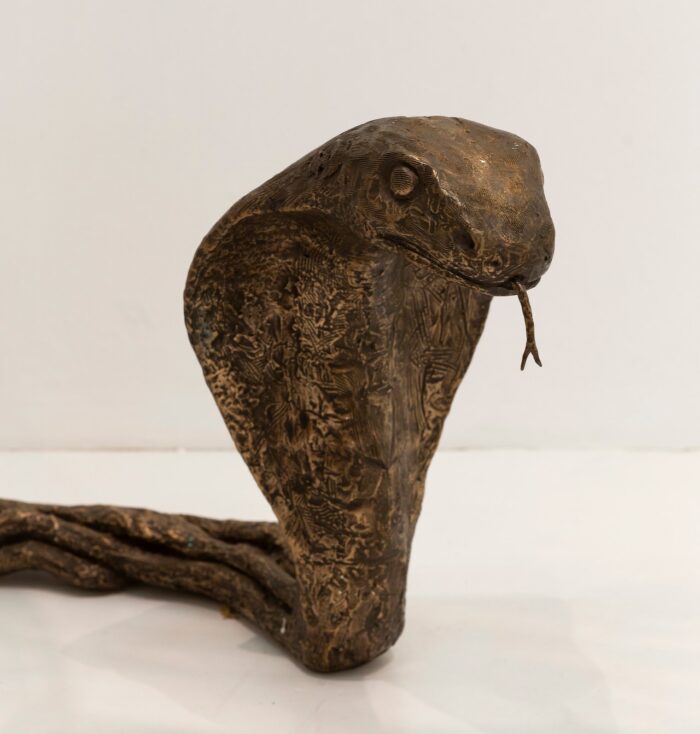
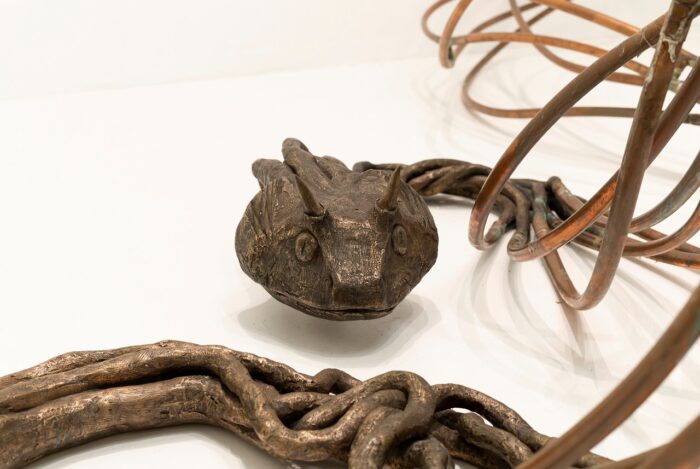
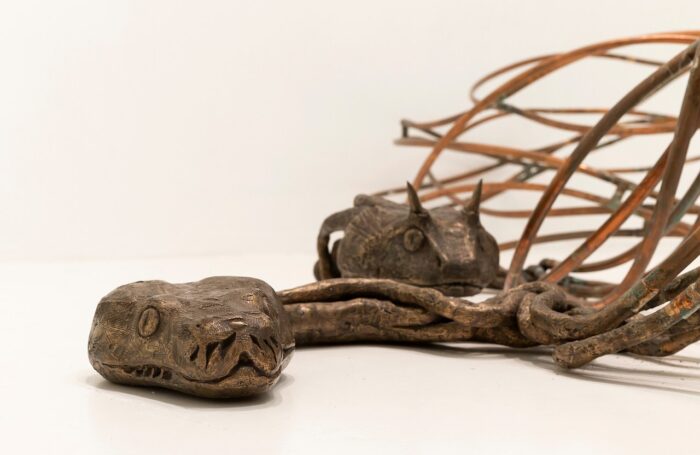
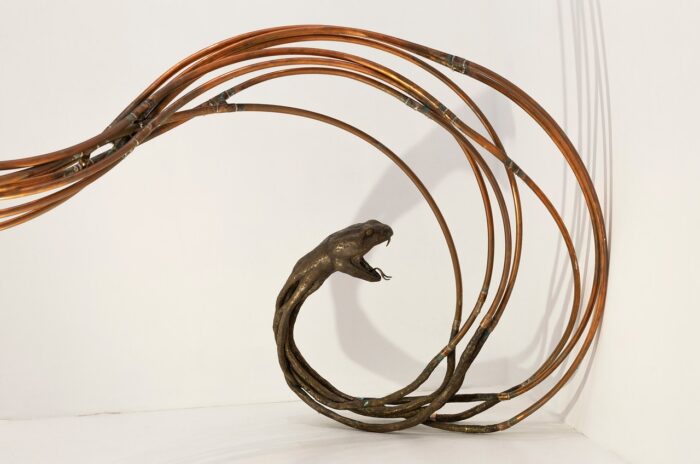
Anchored in the layered context of South Africa and the notion of identity, the work of Nicholas Hlobo (*1975, Cape Town, South Africa; lives and works in Johannesburg) deals with issues of gender, sexuality, spirituality, and ethnicity. His oeuvres span from works on canvas and paper to sculptures and performances, and employ found objects and materials such as leather, rubber, ribbons, bronze and copper. Copper – a natural conductor of electricity – is considered by the artist a ‘conduit’ between different states of being.
On the occasion of his solo exhibition at CCA Tel Aviv, his first solo presentation in Israel, Hlobo presents Inyoka Yobhedu, a site-specific installation consisting of intertwined copper pipes with bronze serpent heads and inspired by Nehushtan [נְחֻשְׁתָּן]. First described in the Book of Numbers, Nehushtan was a bronze serpent on a pole, which Moses created following God’s command so that the Israelites could gaze at it and heal from the bites of the serpents, previously sent to punish them for speaking against God and Moses.
Hlobo titles his works in his native language, isiXhosa and not English, which is more dominant in the field of art. Such a decision generates an intermediate space, where things get lost in translation – a fertile ground for innumerable occurrences and possibilities which allow for the imaginative, the intangible, the dreamful, the emotional, and the intuitive to reveal themselves outside of the orderly structure of language.
Since being introduced to Christianity, the Xhosa people experienced being between two spiritual practices – Xhosa’s ancestral tradition and Christianity. In this context, Inyoka Yobhedu might suggest a link between the liminal condition of the Xhosa people and that of the Israelites at the time of the Exodus. Furthermore, the story of the Israelites, their deliverance from slavery and the journey back home to a promised land evokes the transition of South Africa from apartheid to democracy, the collective historical trauma of both nations and the complex relationship between Israel and South Africa.
Present in numerous religions, the snake has a controversial presence: on the one hand, it represents the devil, temptation and deceit; on the other, it is associated with healing powers and, due to its phallic shape, with sexuality and androgyny. In the Xhosa tradition, the serpent appears in the uMajola totem, which is highly revered and whose role is to visit the homes of newborn babies, bringing fortune and good luck.
Inyoka Yobhedu seems to exist at the crossroads of different cultures and identities, an object capable of transforming dialectic forces into the energy of rebirth and transformation, asking the viewer to play an active role while being in the space and experiencing it. In line with Hlobo’s works – which always preserve the spirit of the creative act and trigger tactile feelings – Inyoka Yobhedu demands a direct engagement. Its copper tubes spreading in the space materialize immeasurable and a-temporal fluxes of energetic and spiritual forces.
“Nicholas Hlobo: Inyoka Yobhedu” is guest-curated by Tamar Dresdner. The exhibition is supported by Wendy Fisher and the Kirsh Foundation and by the artist’s representing galleries – Lehmann Maupin, New York / Hong Kong / Seoul / London and Goodman Gallery, Johannesburg / Cape Town / London; additional support is provided by the Ekard Collection, Chami and Lazar Fruchter, and Carmel and Eran Ilan; hospitality provided by Outset Contemporary Art Fund.
Image: “Nicholas Hlobo: Inyoka Yobhedu,” 2021. Exhibition view at CCA Tel Aviv (detail). Photo: Eyal Agivayev
Nicholas Hlobo: Inyoka Yobhedu with Tamar Dresdner (Hebrew)
